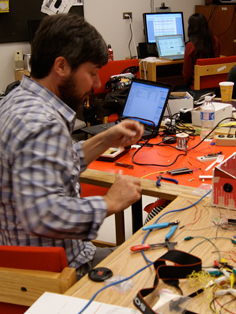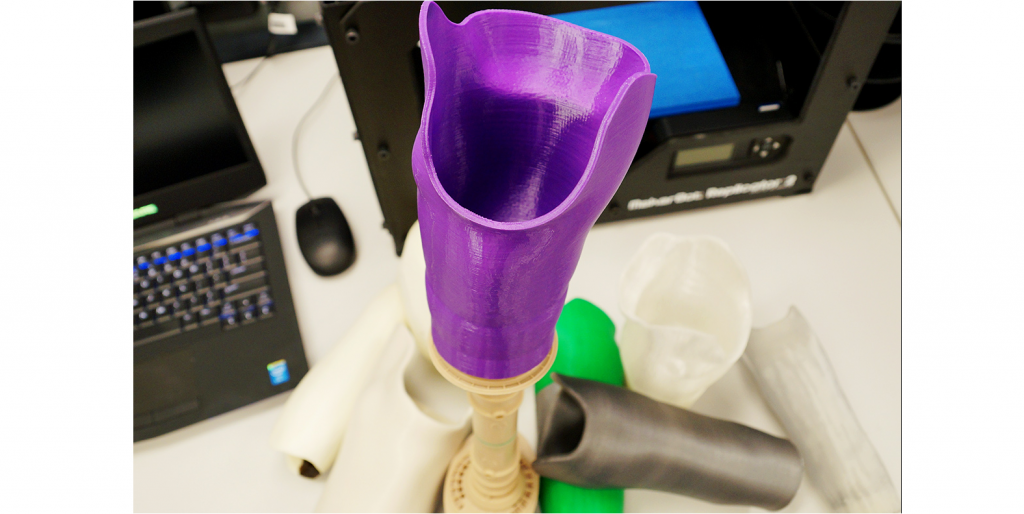Dozens of 3D Printed Lower Leg Prosthetics Are Being Produced at University of Toronto’s Critical Making Lab
 Strides being made in 3D printing and prosthetics inspire me enormously because I know this technology is changing people’s lives in ways they never imagined. Learning about how expensive current prosthetics are and how arduous the task is for having them fitted — especially for children — makes it doubly exciting to think about the new world opened up to those who need replacement limbs.
Strides being made in 3D printing and prosthetics inspire me enormously because I know this technology is changing people’s lives in ways they never imagined. Learning about how expensive current prosthetics are and how arduous the task is for having them fitted — especially for children — makes it doubly exciting to think about the new world opened up to those who need replacement limbs.
In the Critical Making Lab at the University of Toronto, there is a room of 3D printed limbs being refined, with a focus on lower-leg replacements. While 3D printing is certainly changing the price structure and process for prosthetics, it is obviously an area where customization is required, and that can be repeated over and over for growing children. It’s never a one-size-fits-all game.
ginger coons, a PhD student at the Faculty of Information’s Critical Making Lab at the University of Toronto, is involved in working with Associate Professor Matt Ratto to get their lower-limb prosthetic just right. While the ‘legs’ at their lab crowded with 3D printed prosthetics have passed stress testing, the team is still searching for perfection in the correct width and ‘fill’ for supporting a human body.
“I think one of the things we take for granted when we talk about the availability of technology is that not everyone’s infrastructure is our infrastructure,” says coons (who prefers her name be spelled all lowercase).

Matt Ratto is an Assistant Professor and director of the Critical Making Lab in the Faculty of Information at the University of Toronto.
Working on the project since 2013, Ratto is in charge of the mission to find a solid prosthetic design to be used and 3D printed independently in developing countries once personnel there have the training. The comprehensive design Ratto and his team want to perfect needs to be relatively simple and affordable with a design that will be adaptable and easily self-taught. The central focus is on sustainability.
“The social relationships [between] these things matter a lot. And these things have got to be created, developed, made to be sustainable as much as the tech,” Ratto told Fast Company in an interview. “In fact you can’t even differentiate, you can’t even separate the tech from the social. They are irretrievably interwoven together. And I think this is the biggest problem with these kinds of projects, and with technology more generally.”
The prosthetics and designs they currently have in the works are to be tested for the first time next month at a Ugandan hospital, the Comprehensive Rehabilitation Services for Uganda (CoRSU).
With such an expanding group of designers from all disciplines who are passionate about creating 3D printed prosthetics — in this case, hands — research scientist Jon Schull from Rochester Institute of Technology has brought together several thousand volunteers from around the world to participate in e-NABLE, which will be coordinating with hospitals and working diligently to bring new technology and innovation to the world in the area of 3D printing with prosthetics.
The plan is simple: make a design that hospitals and medical professionals in developing countries can use in a self-taught method that offers affordable, functional 3D printed prosthetics for so many in need. With a network in place, and communication for feedback and revisions, the goal is to use the Critical Making Lab in Canada as a home base.
Currently, e-NABLE is working with a great number of volunteers using their own 3D printers to make parts while others assemble them, and yet others check to make sure they are correct and ready for use.
“While we’re doing a lot to make this easier and easier for people to do, there’s no particular reason to think that the person who needs one of these hands will also have the technical skills required to do design or customize or fabricate or fit one of these hands,” Schull explained.

Blue socket – Critical Making Lab [Image: Ginger Coons, Via FastCompany.com]
“The next phase of this work is thinking about how the scaling works. Because you can’t scale out of a research lab. So this idea of a social innovation [or] social entrepreneurship company is what happens next,” Ratto said.
Rather than doing the work for others, Ratto and coons have embarked on what is challenging but most important — they are giving others the tools to perform crucial tasks independently. With so many needs to be filled around the world, it would be unrealistic to think that the project would work without independence and self-sustaining knowledge.
While a learning curve may be challenging at first, the reward will certainly be enormous — and priceless. The goal is to have sixty-five 3D printed prosthetics made for Ugandan children in the next year.
Do you know anyone who would benefit from a 3D printed prosthetic? How do you think 3D printing technology will change the world of replacement limbs? Tell us your thoughts in the Sustainable 3D Prosthetic Designs forum over at 3DPB.com.

Image: Ginger Coons, Via FastCompany.com
Subscribe to Our Email Newsletter
Stay up-to-date on all the latest news from the 3D printing industry and receive information and offers from third party vendors.
Print Services
Upload your 3D Models and get them printed quickly and efficiently.
You May Also Like
Reinventing Reindustrialization: Why NAVWAR Project Manager Spencer Koroly Invented a Made-in-America 3D Printer
It has become virtually impossible to regularly follow additive manufacturing (AM) industry news and not stumble across the term “defense industrial base” (DIB), a concept encompassing all the many diverse...
Inside The Barnes Global Advisors’ Vision for a Stronger AM Ecosystem
As additive manufacturing (AM) continues to revolutionize the industrial landscape, Pittsburgh-based consultancy The Barnes Global Advisors (TBGA) is helping shape what that future looks like. As the largest independent AM...
Ruggedized: How USMC Innovation Officer Matt Pine Navigates 3D Printing in the Military
Disclaimer: Matt Pine’s views are not the views of the Department of Defense nor the U.S. Marine Corps Throughout this decade thus far, the military’s adoption of additive manufacturing (AM)...
U.S. Congress Calls Out 3D Printing in Proposal for Commercial Reserve Manufacturing Network
Last week, the U.S. House of Representatives’ Appropriations Committee moved the FY 2026 defense bill forward to the House floor. Included in the legislation is a $131 million proposal for...


































